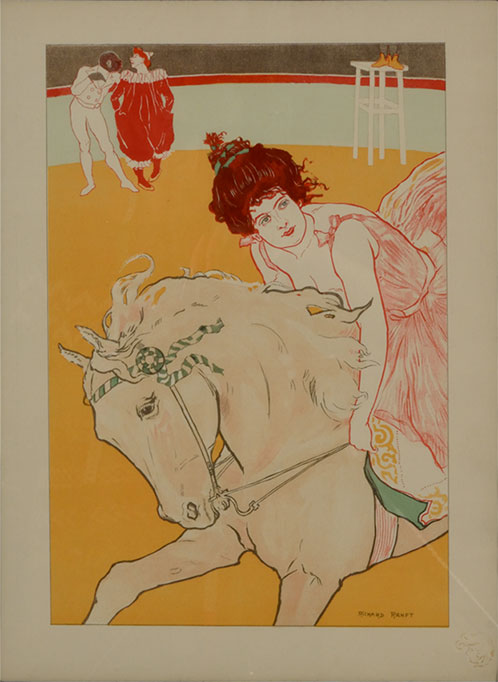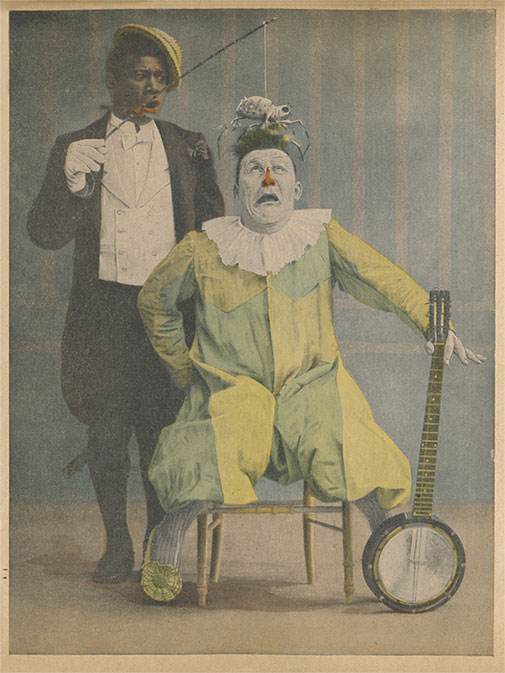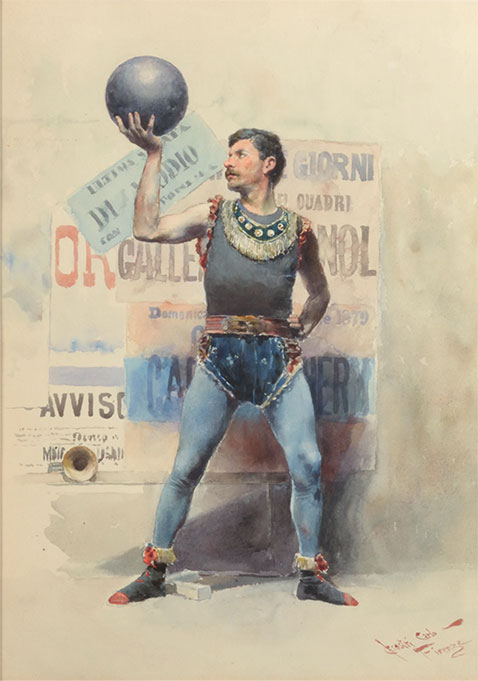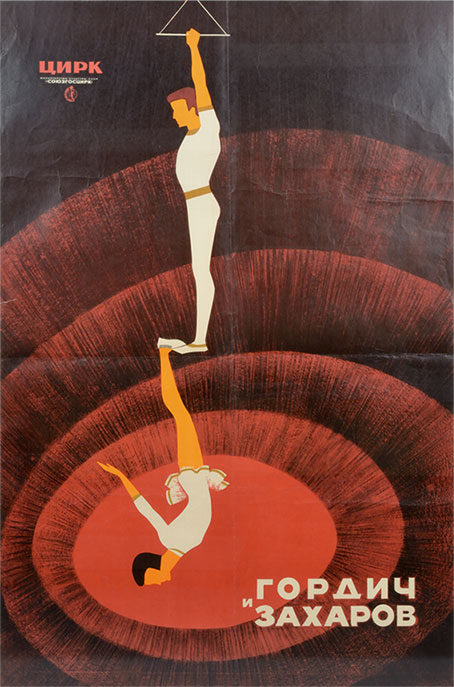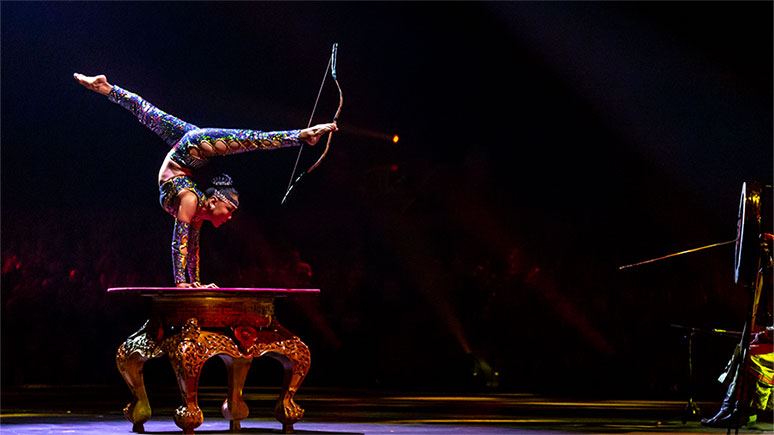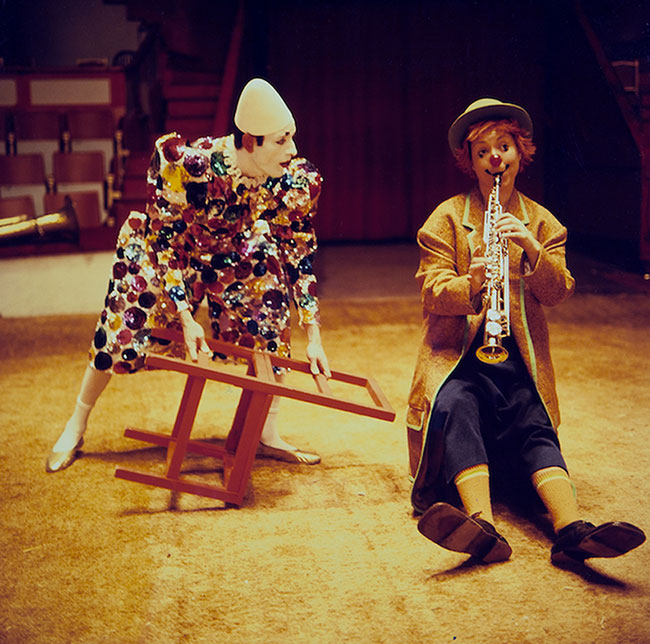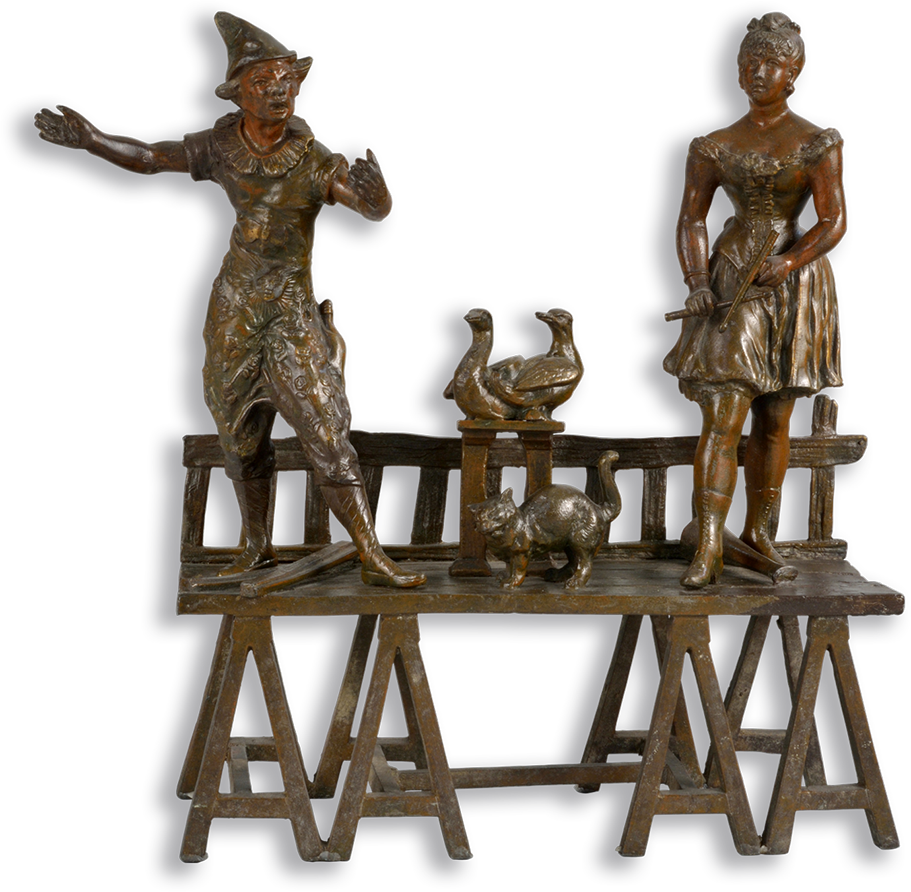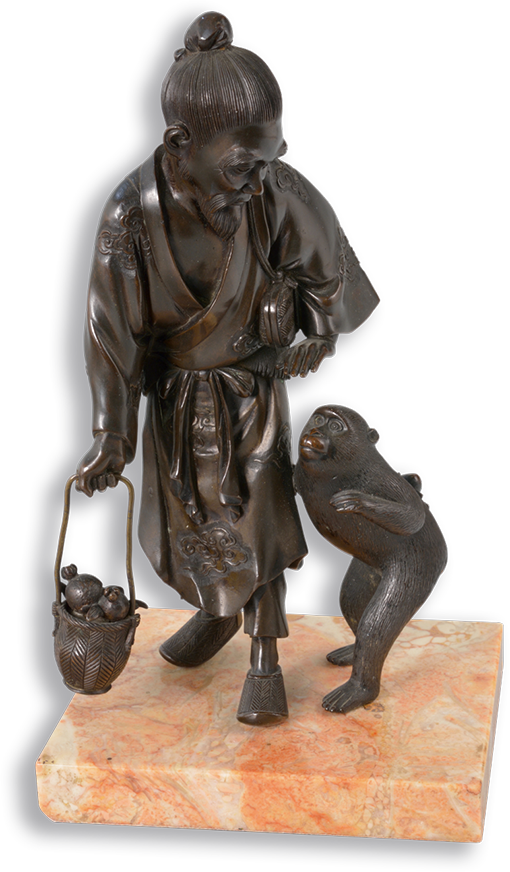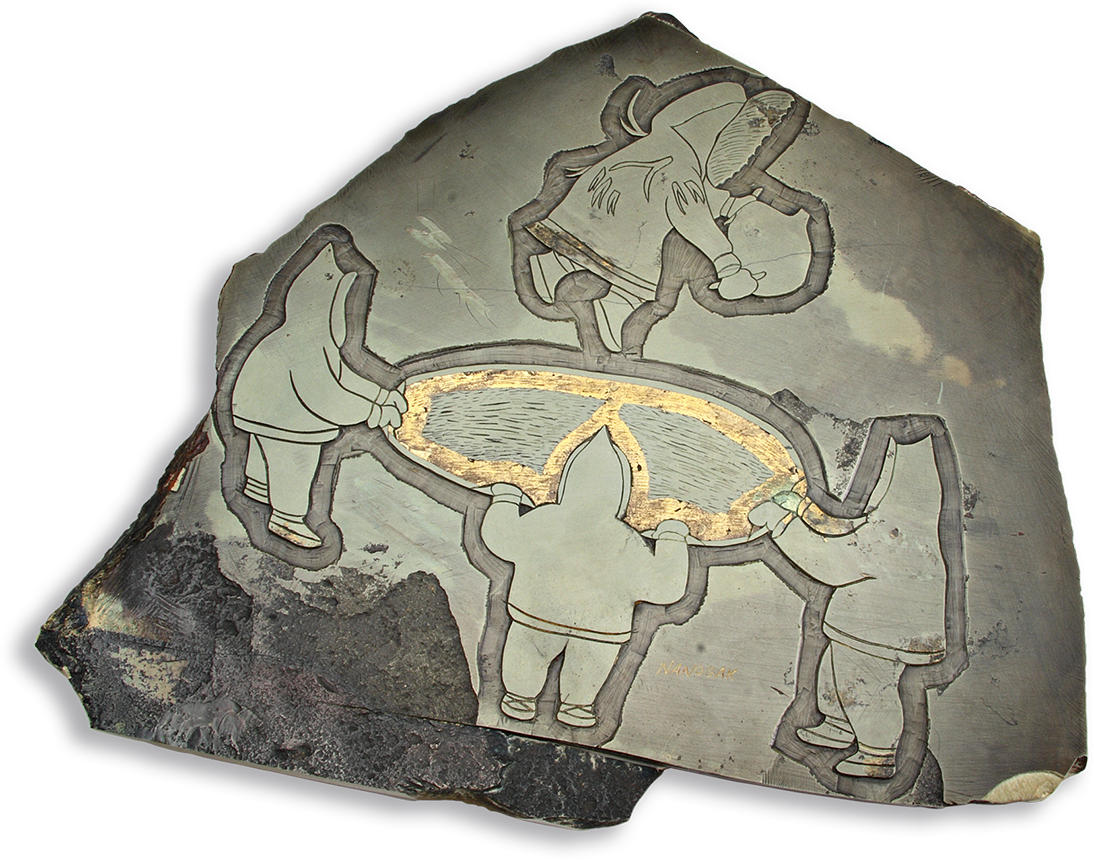Circus History
(A young woman is standing on the TOHU performance stage, facing away from the camera. She is fair-skinned, has her hair up in a double bun and her outfit is red, white and blue. She is looking at something. Strange and mysterious instrumental music plays.)
Narrator: What are you looking at, Luza?
(Luza steps aside, revealing the poster. She gestures to show how beautiful it is.)
Narrator: Oooooh! It’s an antique circus poster!
(Luza moves toward a figurine of a man and a monkey that is sitting on a table. Luza imitates the monkey, then heads toward a painting of a strongman. She imitates him, as well. Realizing that a light is following her, she hides behind a table. She comes out the other side and continues exploring.)
Narrator: You’re curious, aren’t you Luza? You’re going to love exploring the circus world. Since circuses have existed for a long time all around the world, you’ll have lots to discover! The art works you see here are windows on the past. You’ll even meet circus artists from the olden days. Listen to what they have to say so you can earn more stars for your collection!
(Luza walks in front of a mirror and is surprised by her reflection. She makes funny motions in the mirror.)
Narrator: Hey wait, what’s on this poster? It’s you! Hahaha. You can be so funny sometimes.
Equestrienne
Credits: Fonds Jacob-William, TOHU
Drawing of a woman in a pink dress riding a galloping horse in the middle of a ring. Behind them, two people in costume appear to be talking, and the feet of a person standing on a stool can be seen.
Look at this image.
Does it make you think the horse is galloping fast? And that the woman is going to stand on its back?
That’s possible, because she is an equestrienne. That means she can perform incredible acrobatics while she rides her horse.
This image was drawn in France over a century ago. There were many equestriennes at the time, as there are still today. One of them was named Pauline Cuzent. Despite living with a disability, she became one of the top equestriennes of her time. She was the queen of the circus ring.
Chocolat the Clown
Credits: Pascal Jacob Collection, Library of the National Circus School
Photo of Chocolat the Clown wearing a vest and tailcoat and a yellow hat. He is standing with a comical look on his face as he dangles a fake spider over Foottit’s head. Foottit is sitting, holding a banjo and wearing a yellow clown costume. He looks scared.
My name is Chocolat. That’s right, it means chocolate!
Of course that’s not my real name. It’s a stage name I was given because of my skin colour. It’s very disrespectful. But I was born 150 years ago, and at the time, people didn’t think twice about using names like that.
My real name is Rafael. And I was the first famous Black clown in France. Life was hard before I became a performer. I was born a slave in Cuba. That means I wasn’t free. But my parents and I escaped. Then I went to Europe and became a clown.
I was a big star in Paris. All the newspapers wrote about me! Then I met another clown named Foottit. We quickly became a famous duo. He played an authoritarian clown who mocked and slapped me. I played a clown who was silly and a little too nice. People found it very funny.
But I wasn’t really that stupid. Actually, I often got revenge on stage by making fun of Foottit, just like in the photo.
Strongman
Credits: Jacob-William Collection, TOHU
Drawing of a very muscular man in a blue costume effortlessly holding a cannonball in the air with one arm.
Do you think a single man could lift 18 people at the same time? Louis Cyr could!
This Quebecer became the world’s strongest man in 1892. Just like the man in this image, he was muscular and powerful.
Many strongmen travelled from town to town to perform in circuses and strength contests. Some could pull a bus with their hair. Others could lift tremendous weight with their little finger.
Today, there are not just strongmen but strongwomen, too!
P.T. Barnum
Credits: Jacob-William Collection, TOHU
Poster with a photo of P. T. Barnum, “The World’s Greatest Showman,” a photo of a very short man, images of an elephant, horses and circus artists performing acrobatics, and a picture of Barnum’s museum.
Some people call me the Prince of Humbugs. I’m no phony, but if that’s the price to pay for being the man who brings you the most entertainment, so be it!
Ah, sorry! I didn’t introduce myself. My name is P. T. Barnum. I was born in the United States in 1810, and I changed the face of the American circus! I’m not a performer, but I have a talent for business and promotion.
I started with nothing and got rich by showcasing curiosities. From the bearded lady to the world’s shortest man, oh and don’t forget the mermaids, my museum had it all!
Then, in 1871, I created a travelling circus that became the famous Ringling Brothers and Barnum & Bailey Circus. I turned the circus into something big – something huge! My circus didn’t just have one ring. It had three! I had the world’s biggest elephant. Hundreds of thousands of people came to see him. I had my very own circus trains and we toured all over the United States and Canada. We even went to Europe.
So, thanks to me, one and all could see the Greatest Show on Earth!
Russian Trapeze Artists
Credits: Jacob-William Collection, TOHU
Soviet-era poster of two acrobats, one holding on to a trapeze and the other hanging on to the first one by his feet, on a background of spirals to emphasize the feeling of vertigo.
Welcome to the incredible world of the Soviet circus.
The Soviet Union, which included Russia, played an important role in developing the circus arts between 1922 and 1991. The world’s first circus school was founded in Moscow, in 1927. Many artists and circus troupes performed across the Soviet Union and around the world.
Together with engineers, these artists were constantly inventing new acts to enchant their audiences. That was certainly the case with these two trapeze artists.
The Contortionist Enkhtsetseg Lodoi
Photographer : Valérie Thénard Béal
Photo of show where a woman in a blue sequined costume does a handstand on a large table. She has her legs over her head. She is holding a bow with her right foot and appears to have shot an arrow with her left.
This woman, Enkhtsetseg Lodoi, started in the circus at a very young age. She was just 6 when she entered circus school in her country of Mongolia, which is close to China.
With lots of patience, discipline and practice, she gradually trained her body. She became a contortionist. That means that she is very flexible—much more flexible than most of us.
She is so strong that she can shoot an arrow from a bow with her feet while upside down and doing a handstand. Don’t try this at home!
Enkhtsetseg Lodoi was the first Mongolian circus performer to win a gold medal. She loves her art so much that she founded a circus school in Mongolia.
Annie Fratellini, Clown and Educator
Credits: Fratellini Collection
Photo of a fair-skinned woman with red hair and wearing a red nose and oversized shoes. She is sitting in the middle of a ring, playing saxophone. Next to her, a man in a sequined clown costume is holding a red chair. He is wearing a pointy white hat. He has white makeup on his face and red makeup on his ears.
Hello! My name is Annie Fratellini and I was born into the circus. Almost all the men in my family were clowns – my grandfather and his two brothers, my father and his cousins – so guess what I became. That’s right-- a clown. I was one of the first female clowns. I first stepped into a circus ring when I was 13.
But at 18, I wanted to leave the circus, so I became a musician and singer. I was also an actress and appeared in many films.
Eventually, I returned to the circus in a clown duo with my husband Pierre Étaix. As soon as I put on my red wig, round hat, clown nose and oversized shoes, I transformed into a character who brought laughter to children young and old. I loved it!
When I was young, it was hard to break into the circus world if you didn’t come from a family of circus performers. I wanted to change that. So, with my husband, I started France’s first circus school in 1974 to give everyone that first break. Today, there are circus schools just about everywhere!
Sideshow
Credits: Jacob-William Collection, TOHU
“Step right up, step right up, ladies and gentlemen! Discover what our thinking geese can do. Witness our amazing cat count with your very own eyes...”
That’s the sort of thing you’d expect to hear from the man in this picture. He’d call out to people as they walked past his little stage set up on the street.
In Europe street performers and entertainers have travelled from town to town for centuries. They amaze audiences young and old with feats of agility and trained animals.
Monkey Trainer
Credits: Jacob-William Collection, TOHU
Bronze statue of an Asian man wearing a kimono and carrying a basket of fruit. He is looking at a monkey holding on to his leg.
Have you ever seen a monkey dance, walk on stilts or play piano? Yes, it’s true! The monkey you see here was taught all those things by the man beside him. He is called a monkey trainer.
Trainers in Asia and around the world have been working with monkeys and other animals for over 2000 years. They still perform their tricks in streets, at festivals, and in temples.
Today, these shows have been criticized, because their trainers don’t always treat these wild animals humanely.
Blanket Toss
Credits: McCord Museum
Rock carving of four Inuit wearing parkas. Three are holding a blanket tight while the fourth jumps on it and appears to be playing a drum.
Did you know that some forms of acrobatics come from the Inuit culture of northern Canada?
Here, a group is performing the blanket toss. Holding onto the edges of a large animal hide “blanket”, they toss the person in the centre into the air, just like a trampoline.
This technique was originally used by hunters to spot animals in the distance. Today, it is played as a competitive sport at Inuit games and performed as a circus discipline.
Human Pyramids
Credits: Jacob-William Collection, TOHU
Pencil drawing of a four-level human pyramid. A single man is supporting nine other acrobats – four on the second level, three on the third level and one with arms outstretched at the top.
Have you ever lifted a friend off the ground? Have you ever sat – or stood – on your parents’ shoulders? Yes? Now imagine holding up the weight of two, three or even nine acrobats.
Human pyramids have been practised for hundreds of years in Algeria, as seen in this drawing, as well as in Morocco, Spain, Italy, India and elsewhere. It requires exceptional strength and balance.
Look closely. What do you see around the waists of the acrobat at the bottom and the acrobat standing on his shoulders? Here’s a clue: it’s legs!


